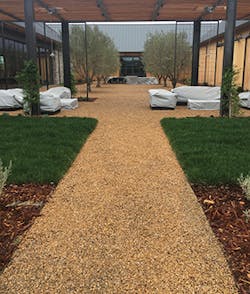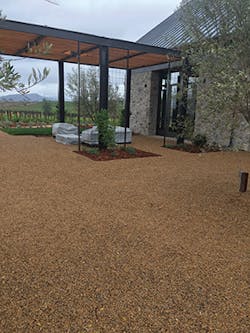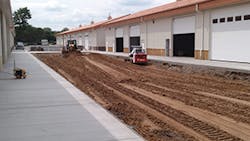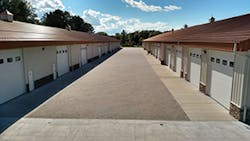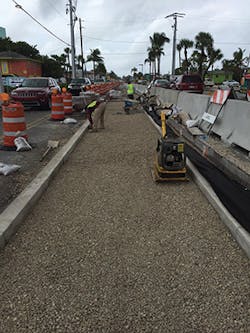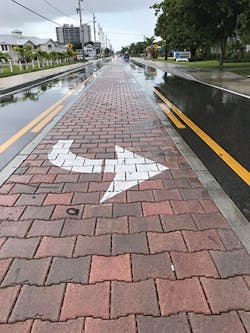Picture the perfect Saturday afternoon—a pleasant temperature, an outdoor wine-tasting event that promises a delicious experience—but wait! A heavy rain fell the night before; the grounds will be muddy, your shoes will sink in, and it’s suddenly sounding less enticing. However, the event planners and winery operators aren’t at all concerned about mud, or customer complaints about wet feet from puddles of standing water.
“In the heart of California wine country, which of course has some very high-dollar real estate, a winery needed to create an outdoor venue for wine tastings,” explains Al Green, the California representative for Colorado-based Invisible Structures. “Holding events outdoors is ideal, but having customers standing around in muddy grass is far less than ideal. Asphalt and concrete surfaces are not only aesthetically undesirable, but they are not in keeping with the ambiance of a winery venue. Asphalt and concrete can also pose maintenance issues and are hot to stand on when outdoors.”
The alternative? “They had heard about our Gravelpave product, which is a proprietary pervious surface with the attributes they were looking for,” says Green.
Andy Gersen, the West Coast stormwater expert at Invisible Structures, recalls that not so long ago, “The extended drought in California and throughout the West was affecting our Grasspave sales, but these all-gravel pavers obviously don’t need any water for maintenance. They capture any rainwater that occurs, an essential benefit in any drought-stricken region.”
He adds that the winery customer wanted a surface that would drain water, would be easy to maintain, and would bring the right “look” to the property for the winery’s entertaining purposes.
“No one will ever have to dodge pools of standing water while balancing a wine glass and cheese plate!” notes Green. Gravelpave2 also offers load-bearing capacity for vehicles up to 80,000 pounds, a heat energy reflectance quality so it provides a cool surface, and easy installation.
“In other words, it’s comfortable on a hot day, easy to navigate on a rainy day, and allows mud-free parking,” says Green. “In California, it’s particularly important to return rainwater to the aquifer, and this system is designed to do just that. Once installed, there is 92% void space, which increases porosity. The additional benefit is its filtration ability to naturally remove contaminants, such as truck or auto hydrocarbons or polluted runoff, before reaching the groundwater.”
Gravelpave2 can be installed in high-use fire lanes, pedestrian walkways, parking aisles and bays, loading docks, boat ramps, and service and access drives.
The winery’s more-than-4,000-square-foot area was first covered with a structural base of Class 2 road base about 6 inches deep, Green says. For increased vehicle use, he notes, a 12-inch base should be installed, “but the winery would not be taking a lot of traffic.”
Next, rolls of Gravelpave2 were laid down over the surface. The product is made of a high-density material “that is 100% made of recycled materials,” says Gersen.
“It’s not only important to create a line of exceptional products to manage erosion and stormwater, but do it in an environmentally responsible manner, which we do, and we take our role in stewardship very seriously; it is and always has been a priority goal since we started 36 years ago.”
The Gravelpave2 resembles a sheet of fabric with a series of low tubes set in a series of rows on a grid throughout the surface. Gersen says that unlike other products, the geotextile backing is neither glued nor mechanically bonded to the grid, “which can break down over time, causing the rest of the unit to lose shape and performance ability.”
He adds, “We use a proprietary process; the bonding will never fail, and the other benefit is it acts as weed control, as well.”
The winery, explains Green, required 6.5-foot-wide by 65-foot-long rolls of the product to cover the surface area, which was about 40 feet wide and 70 feet long.
“The rolls have snap-fit connectors, so after you lay your base course, then you roll out the Gravelpave2, snap it together, and then with spikes pin it to the base course.”
The final step is to infill the open graded surface with decorative aggregate.
Green adds that while maintenance is low, property owners will have to occasionally remove shallow-rooted weeds that pop up. If the product is installed in an area that has significant traffic “coming and going through just one entrance that also serves as an exit, maintaining the aggregate surface is required, but this is simply a matter of raking the aggregate evenly back over the paver when needed every few weeks.”
As California is potentially facing ongoing drought, Green says, evolving regulations in allowing permeable paving makes installing these surfaces an engineer’s answer to many projects.
“L.A. County has now allowed permeable paving, and we want designers, architects, and contractors to envision this is as a much better solution to capture runoff and rainwater and reduce the need for concrete and asphalt surfaces.”
Winery in Santa Ynez, CA
Evolution of Basic Building Blocks
For nearly a century, three generations of the Borgert family have been perfecting concrete products to meet the evolving market needs. With the first concrete blocks fabricated in the 1920s to interlocking concrete paving stones in the ’70s to today’s interlocking concrete permeable pavers, “Bringing customers style and beauty, quality and superiority have been the underpinning of every product,” says owner and CEO Susan Borgert.
Located in central Minnesota, the company avails itself of the regional—and abundant—natural resource, granite. This unique aggregate, whose deposits in the upper Midwest originated from glacier activity millions of years ago, is reported to be the hardest and most durable aggregate next to diamond, and when crushed offers a characteristic angularity that creates a superior bond with cement.
“Interlocking concrete pavements are not only aesthetically pleasing; they provide the end-user with a low-maintenance and exceptional durable pavement, regardless of the style or choice of paver option,” says Borgert.
At Hamline University—“the oldest college in the state,” points out Ken Dehkes, director of facilities operations and horticultural services—“we’ve been using segmental pavers from Borgert since the 1990s. It’s important as a historic institution to maintain a continuity of appearance, and they have been providing us with that look for more than two decades.”
In 2009, however, Dehkes says the university wanted to try an experiment to evaluate Borgert’s interlocking concrete paver options.
“We had to put in a sidewalk where there wasn’t one, so we tried these pavers out on about 5,000 square feet of a walkway. Over the next few years, we were very happy with how they drained water off and how well they blended in visually. When we had an opportunity to use them in 2012 for a new project, we were eager to go ahead.”
Dehkes says that the new building project would initiate “extensive circulation changes, and pedestrian and light vehicle traffic would all be rerouted from what it was.” In other words, the customary routes to and from buildings were going to be altered.
“One of our concerns is that this new building, which would displace the current patterns, would also disrupt our general flow of having all paths convene to our central area, which provides that historic sense of uniformity and cohesion between the sidewalks and buildings. As the oldest college, we need to maintain that historic presence.”
However, Minnesota experiences long winters with snow and ice, so the new pathways would have to be navigable for pedestrians and also for light-duty electric vehicles that need to access buildings. Interlocking concrete pavers, says Dehkes, were clearly the way to go to preserve the school’s appearance and also quickly move off water to prevent ice buildup in winter.
“One reason we like the permeable interlocking concrete pavers is that it is a very cold northern climate, and our frost can go quite deep. If we were to use concrete pavement or asphalt, it’s not nearly as forgiving. The pavers allow for the necessary ground movement, and should one need removing, it’s easy to get to and replace.”
Dehkes explains that there is very good drainage in the region, with little clay in the soil. “It’s a sandy, loamy soil and gravelly, so we wanted to take advantage of that as well. Due to this composite, we didn’t have to put in extensive subsurface drainage.”
He describes the area installed as “just under an acre; about 41,000 square feet was put in. There was one long run that we had to make wider to accommodate heavy emergency vehicles. Initially, there was a 14-foot-wide driveway, but we ended up converting that into big wide sidewalks that would also handle the emergency vehicles and serve as a fire lane.
“At the inner face of the subsoil and base aggregate, we put in a geotextile grid fabric, then an open-graded sub-base of #2 angular stone with no fines, about six inches thick. Then on top of that is a four-inch graded layer of three-fourths-inch stone followed by one to two inches of three-eighths-inch bedding. That material is also used as the infill once the pavers are installed.”
He emphasizes the need to use angular, not rounded or smooth river-type stone. “The angular edges allow for locking into place. Once the pavers were in, we went over the surfaces with a vibration machine to literally shake everything into place and reduce as much air space as possible.”
As an urban campus, he says, Hamline is very sensitive to clean water supply and not overloading the city stormwater infrastructure.
“The more water we can convey to the ground and keep in our natural aquifers, the better. The other benefit is when you have a permeable interlocking concrete pavement in this climate, you also use far less snow removal product. Instead of applying those chemicals, we just put grit down, and actually this helps pedestrian traction and also serves to bolster the infill, so we don’t ever worry about removing it; we just sweep it into the spaces.”
In keeping with the historic aesthetic, Dehkes says, the pavers were laid in a herringbone pattern, which takes a lot of planning to look perfect, especially when making a 45-degree turn. It was finished off with a double soldier course “that further enhances our classic look,” he says.
“Through deft geometrics and planning, your eye is never distracted from the layout of the buildings.” He adds that Borgert’s color blends are consistent with the campus structures, giving the walkways a common look with the buildings.
“I wanted a classic look that would hold up in perpetuity. As I come from the horticulture and green side of facilities, I love green spaces. This is not only an economically wise investment that is not a hardship; it’s simply the right thing to do.”
Making Man Caves Amazing
Back in the day, the basement or garage was the understood domain of men who got together in these sanctified spaces that were generally off limits to kids, women, and Siamese cats. Lawn chairs, ashtrays, and unshaded bulbs were the usual informal appointments to discuss cars, sports, and music. Decades later, a 1992 Toronto Star article gave this retreat a new name: the man cave. Suddenly massive audiovisual setups, sophisticated beverageware, and leather sofas were de rigueur, and the name stuck.
And now, at Garage Solution Condominiums, developer Joe Bazey says the concept has evolved from a place where you talk about cars to a swanky space to actually store your vintage vehicle (or anything else).
“I call these the ultimate man cave—mini-storage on steroids,” says Bazey from his Columbus, MN, facility that he reports is 100% occupied with a waiting list that keeps growing.
He says he got into the garage condominium business because he himself needed a space for storing tools, equipment trailers, and cars and wanted to have a nice place to work on them, but it was hard to find the right situation. So he bought some land and made his own, and, anticipating its desirability, offered it to others. It proved to be very popular, and he intends to break ground on the second expansion in the spring of 2019.
Bazey says the 98 units total 153,000 square feet and range in size from 1,000 to 6,700 square feet. He installed in-floor heat, floor drains, and sewer hookups, and each unit has running water and electricity.
“The garage condominiums are designed to have a 56-foot drive aisle between buildings to allow for trailers and RVs to get into the garages,” he says. “Then, out of this 56 feet, there is a 10-foot apron in front of each building. The remaining 36 feet has permeable pavers installed that run the whole length of the building.”
Bazey says his choice of Borgert permeable pavers was a good one because they help him meet the city and watershed district ordinance of keeping water on the property.
“I first looked at pervious concrete, but the problem is you have a 30-day cure time. I couldn’t tell customers that they weren’t able to drive into their garage for over a month. I talked to Borgert about our options, and with the help of a civil engineer, we evaluated our subsurface and came up with the right layering, volume, and size of rock for the base and infill.”
He says the key is to use clean, washed, crushed rock that will “choke down on itself and fill the voids, making filtration and drainage better.”
He notes, “If we get a five-inch flash rainstorm, it does fill up, but in less than an hour, it’s gone. We did install some pipes to divert the overflow for some of these massive rain events, but with these pavers we never see standing water. This is great for the owners who want to access their property year-round and expect a well-maintained appearance. With Borgert’s help, we picked out a color called River Blend, which blends perfectly with the stone wainscot on the side of the building.”
Bazey says that they ended up using 62,000 square feet of the pavers. “It was great to work with a local company to get the materials needed and create the ideal look.” And with the new buildings slated for 2019, he says, he will “of course be using them again.”
Staying Cool at the Brewery
After working to perfect the concept, Houston-based entrepreneur and plastics engineer Barry Stiles launched his TRUEGRID plastic permeable paver.
“We had been working on it for a while, but by the end of 2013 our patented grid system had been perfected and offers customers a zero-runoff, sustainable, and very strong permeable system,” he says.
“This basic concept has been around for a while, but we were the first to handle heavy industrial and commercial paving applications. Here in Houston, there is a lot of flooding, and a robust plastic paver is ideal. Ours has the ability to contour to the ground and is made of 100% post-consumer recycled plastic. So your old shampoo bottle from Harrisburg might be holding down the runoff in Houston, or anywhere else.”
Stiles says the company injection-molds pelletized post-consumer high-density polyethylene plastic, with carbon black added for UV protection, and manufactures the grids in Texas.
“Each piece is two feet by two feet, and they come on a pallet and are preassembled in four pieces. That whole section weighs only 22 pounds, yet it has a compressive strength rating of HS-20. We’ve had 260,000-pound cranes drive over these in daily use, so to claim they are rugged and robust is not an overstatement.”
Permeability is another key. “We are all about managing stormwater, and the results of independent third-party testing reported that our system can absorb rainfall at a rate of 800 inches of water per hour. Rain is absorbed through the surface essentially instantly and is detained in the gravel sub-base with 40% void space below. If you need more detention, you can add a deeper base.”
The system “helps cleanse the stormwater through the natural filtration activity of percolating through rock and into soils,” he says. “It helps with removing hydrocarbons before the water recharges the aquifers. In large installations, it’s engineered to help prevent flash floods. As the detention capacity is filled, the stormwater is slowly released and directed to the city stormwater system. This reduces the strain on the city system and helps reduce street flooding.”
Stiles says one recent project helped a Houston microbrewery stabilize erosion of a gravel lot and manage detention and runoff.
“About five years ago, the microbrewery craze started here in Houston, and the Saint Arnold Brewery turned a historic warehouse into a microbrewery. One of the parking areas needed soil remediation to remove soil contaminants from legacy operations.
“We worked with the contractor to add permeability and detention to the 25,000-square-foot lot with TRUEGRID. Six months later, we did another lot across the street with our then-new SuperSpots, snap-in plastic parking space markers for ‘striping without paint.’ It’s maintenance-free, and if you want to change the configuration, you can pop up the spots and define other spaces.”
Five years later, the brewery added a new beer hall and converted an old city tow lot to a parking area. In this case, the product was used to stabilize the compacted gravel lot and prevent erosion.
The aggregate also reduces heat island effect; patrons of the brewery’s restaurant and tours find the parking lots are dry to drive and walk on and can enjoy the outdoor dining area without sweltering from radiant ground heat.
While many green solutions are more expensive than the traditional practice, “which often detours designers away from those choices,” Stiles says TRUEGRID installations cost less than concrete.
Although it almost never snows in Florida, Greg Strickland of Fort Myers-based Titan America, one of the PaveDrain manufacturers, says there is plenty of rain and runoff in the hurricane-prone state.
“We make the PaveDrain in a dry-cast machine where the mix is compressed in molds, giving them a 4,000 psi tensile strength. The patented arch design makes the blocks lighter than if they were a full 12-by-12 solid. They were used for the Estero Boulevard project down in Fort Myers Beach.”
Strickland explains that the town of Fort Myers Beach is actually an island off the Florida mainland by Fort Myers, barely wider than a mile and about 7 miles long, with Estero Bay on one side and the Gulf of Mexico on the other. Fort Myers Beach is a year-round tourist destination, and Estero Boulevard is the access highway to the beach and tourist resorts.
But in two main segments, the roadway was continuously plagued with standing water and runoff—even after small rainfall events.
“Every time it rained it was a problem. They had no place for water to drain and no land for a pond. The water would flood sidewalks and, being a big pedestrian route, this was bad for business and visitors,” he explains.
In a bold move, he says, the solution involved excavation of the center of the highway in the trouble spots, actually lowering the roadway and “creating a reverse-crown effect,” which directed stormwater toward the middle of the roadway rather than toward the homes and businesses.
“Some people thought, ‘If you can’t drain the water, how will lowering the road help?’ but it’s really genius. What they did was put in four feet of open-graded aggregate under the road, and of course the base soil is sandy, so if you just capture the water via the PaveDrain system it’s going to drain practically straight down. Then if it gets to a certain level and the water table rises, it is conveyed to an outfall and goes either to the Estero Bay side or the Gulf side,” he says.
The PaveDrain blocks are located in the center of the roadway as a turn lane and held in by a curb of concrete, with asphalt roadway lanes on both sides, then raised sidewalks.
Strickland says that because the blocks have a 1/4-inch gap created by spacer bars configured into their shape, “as the blocks fit together, this gap takes in the water very quickly and conveys it to the gravel underneath, then to the subsurface and either to an outfall or to the aquifer.”
Strickland says he visited the site after completion; it had just rained, “but you didn’t see any standing water.”
He adds, “Before when the water ran off, there were untreated pollutants going into the bay, but now there is good filtration and nutrient and sediment removal.”
